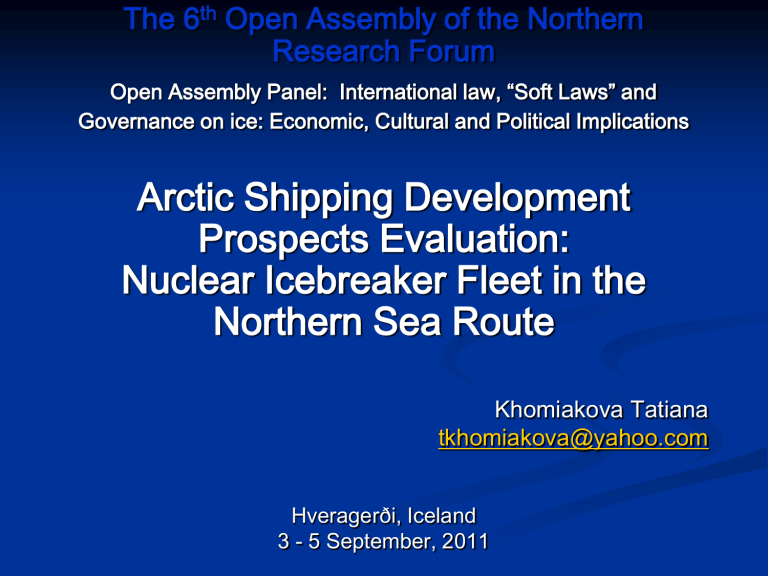- Arctic Portal Library

The 6 th Open Assembly of the Northern
Research Forum
Open Assembly Panel: International law, “Soft Laws” and
Governance on ice: Economic, Cultural and Political Implications
Arctic Shipping Development
Prospects Evaluation:
Nuclear Icebreaker Fleet in the
Northern Sea Route
Khomiakova Tatiana tkhomiakova@yahoo.com
Hveragerði, Iceland
3 - 5 September, 2011
1. Data and Methodology
This research is supported by the unique database of potential investment projects in all sectors of Russia’s economy and, in particular, infrastructure development projects in all regions of Russia till year 2020.
The database has been collected in the course of the structured request to the Federal authorities, regional authorities and business in Russia.
The research methodology comprises of:
1) qualitative methods
2) mapping and geographic analysis techniques
(MapInfo);
3) quantitative methods.
2
Transport Corridors, Natural Resources Development Territories,
Processing Industry Territories in Russia till Year 2020
- - Northern Sea Route
Natural Resources Development Territories: extraction of fuel and energy mineral resources precious metals and precious stones extraction, extraction of widely-spread resources, extraction of other resources
Source: Author
3
Natural Resources Development Territories
Generating NSR Cargo Flows
1) Oil and gas
Yamal Peninsula - main Arctic energy province for decades to come
hydrocacrbon reserves of the Yamal Peninsula - 50 trillion m 3 up to 65 million tons of gas will be supplied to the Asian-
Pacific markets after the construction of several LNG plants
2) Non-ferrous Metals, Ferrous Metals and Other Ore Minerals
about 85% of nickel , 60% of copper reserves, and over 95% of platinum is concentrated in the Norilsk industrial region;
manganese ores and complex ores in Novaya Zemlya; ore minerals in Taimyr and Northern Yakutia.
4
New Opportunities for the NSR
The NSR cargo load will intensify owing to new railway siding to the White Sea, Barents
Sea and Kara Sea.
5
Nuclear-Powered Icebreaker Fleet in Russia
Nuclear Icebreaker Fleet
(operated by Rosatomflot)
10 Nuclear Icebreakers Special Vessels
6 Nuclear Icebreakers Nuclear
Container
Carrier
“Sevmorput” (1988
3 Decommissioned icebreakers: i/b “Lenin” (1959), i/b “Sibir” (1978), i/b “Arctika”
(1975)
5
Special
Vessels
2
Decommissioned Special
Vessels: mv “Lepse” and mv
“Volodarsky”
4 Icebreakers of
Arctika Type: i/b
“Rossia” (1985), i/b “Sovetsky
Soyuz” (1989), i/b “Yamal”
(1992), i/b “50
Let Pobedy”
(2007)
2 Icebreakers of
Taimyr Type: i/b “Taimyr”
(1988), i/b “Vaygach”
(1990)
(river icebreakers)
Rossita
4 special technological vessels
6
Annual Freight Traffic Activity on the NSR, million ton
Year Freight Traffic Activity
1987 6.579 (max)
1998 1.458 (min)
2000
2005
2009
2010
2011
2012
2015
2020
2025
2030
1.587
2.023
2.0
1.8
3
5
75
90
100-130
Source: Cited as in “СМП вновь оживает” (NSR is revitalizing again,
April 29, 2011) for years 1987-2010 and author’s estimates for years 2011-2030
7
Transit Potential of the NSR as Nexus between
Europe and Asia-Pacific Region
5 years ago, UN estimated transit fotreign cargo:
5-6 million ton a year in the eastern direction
2-3 million ton a year in the western direction
The transit routes through the NSR:
are quite attractive for foreign cargo owners have great potential to attract transit cargoes in the Arctic
In August 2010, a pilot transit of the Arctic ice class
1А Super (Arc5) tanker «SCF Baltica» on the NSR tanker delivered 70,000 of gas condensate of
“Novatek” company from Murmansk to Ningbo (China) via the NSR
8
Requirements for an Economical Usage of the
NSR
operational perspective
ice route optimization system
administrative perspective
regulation and fee structures
9
4 Sateges of the Nuclear Icebreaker Fleet
Development till Year 2030
Stage 1. Years: 2010-2015
Stage 2. Years: 2015-2020
Stage 3. Years: 2020-2025
Stage 4. Years: 2025-2030
10
Stage 1. Years: 2010-2015
Brief Characteristics of Stage 1 Measures to be Implemented
The annual total freight traffic along the NSR may exceed
5 million ton in year 2012 and 20 million ton in 2015.
Stage 1 is characterized by:
1) stabilization of commercial demand for nuclear icebreaker fleet services at a relatively low level,
2) growth of commercial demand for nuclear icebreaker fleet services is possible by the end of the period.
3) services volume growth for state needs.
1. Bringing the number of nuclear icebreakers in line with the existing demand for services and performance of public duties. Staff restructuring.
2. Construction of 1 universal new series nuclear icebreaker with the overall power of 60 MW will be launched in 2012 and will be completed in 2016.
3. Activities deployment on utilization of the decommissioned nuclear icebreakers.
4. Remedial maintenance base modernization launch, primarily, spent nuclear fuel).
the security equipment modernization (operations with radioactive waste and
5. Relationship restructuring between the nuclear icebreaker fleet operator – Rosatomflot – and the
State.
6. Start of work on the formation of PPPs to enhance the major customers’ products logistics effectiveness.
11
Stage 2. Years: 2015-2020
Brief Characteristics of Stage 2 Measures to be Implemented
The annual total freight traffic along the NSR may reach 45 million ton by year 2020.
Stage 2 is characterized by:
1) moderate growth in demand for commercial services,
2) significant amount of services for State needs.
1. Maintain the number of nuclear icebreakers in accordance with the demand for commercial services and guaranteed execution of public duties by carrying out nuclear icebreakers’ life extension.
2. By the year 2020, construction of 3 universal nuclear icebreakers of type LK-60 N with the overall power of
60 MW each. The nuclear icebreakers are slated for delivery in year 2016, 2018 and 2020.
3. Activities on utilization of the decommissioned nuclear icebreakers (if necessary).
4. Maintenance (repair & servicing) facilities modernization completion, including facilities for the safety.
Nuclear Icebreaker Fleet will participate in the expanding use of the NSR for international cargo transit between Europe and Asia.
5. Establishment and execution of government orders system improvemnent.
6. Rosatomflot participation in the formation of transport and logistics system in the Western
Arctic on the condition of PPP.
12
Stage 3. Years: 2020-2025
Brief Characteristics of Stage 3 Measures to be Implemented
The annual total freight traffic along the NSR may reach 75 million ton by year 2025.
2) gradual growth in demand for commercial services in the
Eastern Arctic.
1. Maintain the number of nuclear icebreakers in accordance with the demand for commercial services and guaranteed execution of public duties by construction of new nuclear icebreakers.
Stage 3 is characterized by:
1) the strong growth in demand for commercial services in the
Western Arctic,
2. Activities on utilization of the decommissioned nuclear icebreakers (if necessary).
3. Maintenance facilities (including facilities for safety) readiness for the complete cycle maintenance for a new generation nuclear icebreaker placing into operation. Scaling up the use of maintenance facilities.
The volume of services for the
State needs will remain.
Nuclear icebreaker fleet will take part in advancing the NSR use for international cargo transit between Europe and
Asia.
4. Rosatomflot participation in formation - on the condition of PPP – of the integrated transport and logistics system throughout the NSR.
5. Rosatomflot contribution – on the condition of PPP – to growth in international cargo transit on the NSR.
13
Stage 4. Years: 2025-2030
Brief Characteristics of Stage 4 Measures to be Implemented
The annual total freight traffic along the NSR may reach more than 100 million ton by year 2030.
1. Maintain the number of nuclear icebreakers in accordance with the demand for commercial services and guaranteed execution of public duties by construction of new nuclear icebreakers.
2. Activities on utilization of the decommissioned nuclear icebreakers (if necessary).
Stage 4 is characterized by:
1) moderate growth in demand for commercial services in the Western Arctic,
2) faster growth in demand for commercial services in the Eastern Arctic.
The volume of services for the
State needs will reduce.
Nuclear icebreaker fleet will be involved in the NSR’s steady tranformation into a year-round trsansportation route.
3. Maintenance (repair and servicing) facilities
(including facilities for safety) readiness for the complete cycle maintenance for a new generation nuclear icebreaker placing into operation.
4. Rosatomflot participation in development – on the condition of PPP - of the integrated transport and logistics system throughout the NSR.
5. Rosatomflot contribution – on the condition of PPP – to growth in international cargo transit on the NSR.
6. Construction and placing into operation of at least two new generation serial nuclear icebreakers.
14
7. Conclusions
intensity of transportation has a decisive impact on where northern cities and Arctic regions will prosper
construction of 3 new universal nuclear icebreakers is of paramount importance in accordance with the projected freight traffic on the NSR
75 million ton in 2020,
90 million ton in 2025,
> 100 million ton in 2030
the resource extraction companies (e.g. Norilsk Nickel) outline the importance of nuclear icebrekers on the NSR for rescue operations and safety provision
not only safety, but also regulation and fee structures are crucial for economical use of the NSR, particularly by foreign cargo and ship owners
to base at least one nuclear icebreaker in the Eastern
Arctic 15




![The Politics of Protest [week 3]](http://s2.studylib.net/store/data/005229111_1-9491ac8e8d24cc184a2c9020ba192c97-300x300.png)



